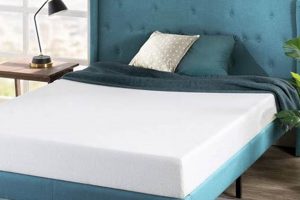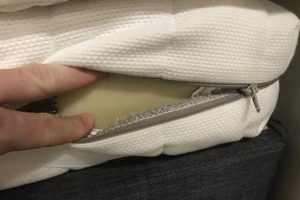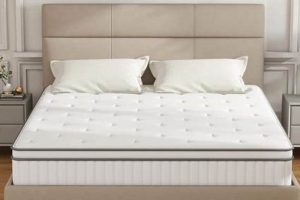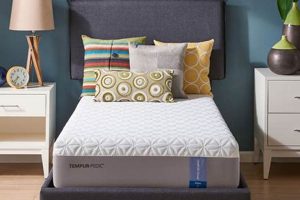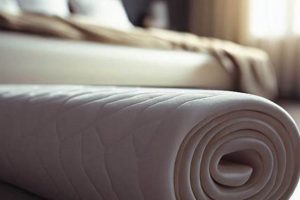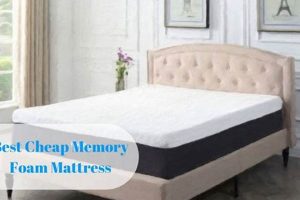Linens designed for use on viscoelastic polyurethane foam sleeping surfaces represent a specific category of bedding accessories. These textiles are crafted to complement the unique characteristics of the mattress material, which conforms to the sleeper’s body and distributes weight. The selection of appropriate coverings impacts both comfort and the longevity of the foam.
Selecting the correct type significantly influences the sleeping experience. The ability of the foam to contour can be hindered by restrictive fabrics, reducing pressure relief. Breathable materials promote airflow, mitigating heat retention often associated with these mattresses. The historical use of natural fibers, like cotton, contrasts with the increasing popularity of synthetic blends designed for enhanced moisture-wicking and durability.
The following discussion will delve into material types suitable for these mattresses, thread count considerations, weave patterns, and proper care instructions. Attention will be given to how these factors contribute to optimal comfort and mattress preservation.
Essential Considerations for Selecting Mattress Linens
Optimizing the lifespan and comfort of a viscoelastic polyurethane foam sleeping surface requires careful selection of appropriate linens. The following tips provide guidance on choosing coverings that complement the unique properties of this mattress type.
Tip 1: Prioritize Breathable Materials: Opt for natural fibers like cotton, linen, or bamboo, or synthetic blends engineered for breathability. These materials facilitate air circulation, preventing heat buildup commonly associated with memory foam.
Tip 2: Consider Weave Density: A lower thread count percale weave offers enhanced breathability compared to higher thread count sateen weaves. Adjust based on individual temperature preferences.
Tip 3: Evaluate Fabric Softness and Texture: The surface feel impacts overall comfort. Test different materials to determine personal preference for smoothness or texture against the skin.
Tip 4: Ensure Proper Fit: Deep-pocket options are often necessary to accommodate the thickness of memory foam mattresses. Ensure a snug fit to prevent slippage and maintain a smooth sleeping surface.
Tip 5: Account for Mattress Protector Compatibility: If using a mattress protector, ensure the chosen linens are compatible in terms of thickness and breathability. A non-breathable protector negates the benefits of breathable linens.
Tip 6: Regularly Launder Linens: Frequent washing removes accumulated body oils and dust mites, contributing to hygiene and maintaining the integrity of the fabric fibers. Follow manufacturer’s instructions for optimal care.
By carefully considering these factors, individuals can enhance the comfort, longevity, and hygiene of their viscoelastic polyurethane foam mattresses.
The next section will address common misconceptions surrounding mattress linens and provide clarity on the often-confusing terminology associated with bedding.
1. Material Breathability
The breathability of the fabric used in linens is paramount when considering viscoelastic polyurethane foam mattresses. Due to the density of this foam and its tendency to conform closely to the body, adequate airflow is essential to prevent heat retention and maintain a comfortable sleeping temperature. The intrinsic properties of different materials significantly influence this aspect of thermal regulation.
- Fiber Composition and Air Permeability
Natural fibers such as cotton, linen, and bamboo possess inherent air permeability due to their structure. This allows for the passage of air through the fabric, facilitating the evaporation of moisture and reducing heat buildup. In contrast, tightly woven synthetic materials may restrict airflow, leading to discomfort and increased perspiration during sleep. Examples include percale cotton, known for its crispness and breathability, versus tightly woven polyester, which may feel warmer.
- Weave Density and Airflow Channels
The density of the weave also plays a crucial role. Looser weaves, like percale, create more space between the threads, allowing for greater airflow compared to denser weaves such as sateen. This difference can be significant for individuals sensitive to temperature variations during the night. The selection of an appropriate weave can mitigate the insulating properties of the foam and promote a cooler sleeping environment.
- Moisture-Wicking Properties and Evaporation
Beyond airflow, the ability of a material to wick moisture away from the skin is essential. Materials like bamboo and certain synthetic blends are engineered to actively transport moisture to the surface of the fabric, where it can evaporate. This process helps to regulate body temperature and prevent the buildup of humidity between the sleeper and the mattress. The effectiveness of moisture-wicking properties contributes directly to sleep quality.
- Impact on Thermal Regulation and Comfort
The cumulative effect of fiber composition, weave density, and moisture-wicking capabilities determines the overall thermal regulation provided by the linens. A breathable material prevents overheating and promotes a more consistent sleeping temperature, reducing nighttime awakenings and improving sleep quality. The choice of fabric directly impacts the comfort level experienced on a viscoelastic polyurethane foam mattress.
The interplay between these factors underscores the importance of selecting bed linens with a focus on material breathability. The ability of the chosen fabric to facilitate airflow, manage moisture, and regulate temperature directly affects the comfort and overall sleep experience on this type of mattress, underscoring the need for careful consideration during the selection process.
2. Thread Count Balance
Thread count, the number of horizontal and vertical threads per square inch of fabric, is a common metric for assessing the quality of bed linens. However, its relevance to viscoelastic polyurethane foam mattresses extends beyond simple quality assessment. The ideal thread count represents a balance between softness, breathability, and durability. Higher thread counts do not automatically equate to superior performance, particularly when used with foam mattresses. A thread count that is too high can restrict airflow, exacerbating the heat retention issues often associated with this mattress type.
The practical significance of understanding this balance lies in the enhanced sleep experience. For example, using a 600-thread-count sateen sheet on a foam mattress might feel initially luxurious. However, the dense weave could trap heat, leading
to discomfort and restless sleep. Conversely, a 300-thread-count percale sheet, with its looser weave, promotes better ventilation, creating a cooler, more comfortable sleeping environment. The intended effect is to maximize the inherent benefits of the foam pressure relief and support without the drawback of overheating. Moreover, excessive thread counts can increase the sheet’s weight and stiffness, which may detract from the conforming properties of the mattress. Durability, while important, should not overshadow the primary need for breathability on a foam surface.
In conclusion, the selection of linens for viscoelastic polyurethane foam mattresses requires a nuanced approach. Thread count should be considered in conjunction with material type and weave to optimize comfort and thermal regulation. Prioritizing a balanced thread count, one that favors breathability over sheer density, contributes to a more effective and enjoyable sleep experience. The challenge lies in educating consumers to look beyond the marketing hype surrounding high thread counts and instead prioritize materials and weaves that complement the unique properties of their mattress.
3. Weave Pattern Texture
The texture of bed linens, determined by the weave pattern, significantly influences the comfort and overall sleeping experience on a viscoelastic polyurethane foam mattress. This connection arises from the direct contact between the fabric and the sleeper’s skin, coupled with the unique properties of the foam. A rough or abrasive texture can detract from the pressure-relieving benefits of the mattress, while a smooth, soft texture enhances comfort. The choice of weave pattern, therefore, becomes a crucial factor in optimizing the user experience. For example, percale, with its plain weave, offers a crisp, cool feel that is beneficial for hot sleepers. However, its slightly rougher texture might not be ideal for individuals with sensitive skin. Conversely, sateen, characterized by a satin weave, provides a silky-smooth texture that many find luxurious. However, its tighter weave can reduce breathability, potentially leading to heat retention. Understanding these trade-offs allows informed decisions tailored to individual preferences and needs.
Further consideration involves the interaction between the weave pattern and the mattress’s contouring ability. A highly textured weave, such as seersucker, might interfere with the foam’s capacity to conform to the body’s shape, reducing the effectiveness of pressure distribution. In contrast, a smoother weave allows the mattress to mold more closely to the body, maximizing pressure relief. Moreover, the durability of the weave is relevant. Tightly woven patterns generally exhibit greater resistance to wear and tear, prolonging the lifespan of the linens. The choice of weave also affects the care requirements. Delicate weaves, like linen or silk, often necessitate special washing and drying procedures, while more robust weaves, such as cotton percale, can withstand more frequent and rigorous cleaning.
In summary, the weave pattern texture is an integral component of bed linens for viscoelastic polyurethane foam mattresses. The texture directly impacts comfort, affects the mattress’s contouring ability, influences durability, and dictates care requirements. The selection of the appropriate weave requires a balanced assessment of individual preferences, sensitivity to temperature, and willingness to adhere to specific care instructions. Prioritizing this understanding allows consumers to optimize the sleep experience and prolong the lifespan of their bedding.
4. Pocket Depth Compatibility
Viscoelastic polyurethane foam mattresses often possess greater thicknesses than traditional innerspring models. This increased height necessitates that linens feature appropriately sized pockets to ensure a secure and proper fit. Insufficient pocket depth results in the fitted sheet slipping off the mattress corners, causing discomfort and disrupting sleep. The proper selection of linens, therefore, depends on the precise measurement of the mattress depth and matching it to the stated pocket depth of the bedding. For instance, a mattress measuring 14 inches in thickness requires sheets with a pocket depth of at least 15 inches to accommodate the mattress fully and prevent slippage. The failure to consider this aspect leads to premature wear on the sheets due to increased tension and friction, and negatively impacts the overall sleep quality.
The availability of various pocket depths addresses the diverse range of mattress thicknesses present in the market. Deep-pocket sheets, typically ranging from 13 to 17 inches, cater to thicker foam mattresses, including those with added pillow tops or integrated comfort layers. Extra-deep-pocket sheets, exceeding 17 inches, are designed for particularly thick mattresses, often found in luxury or specialty bedding configurations. Ignoring pocket depth incompatibility not only impacts comfort but also affects the longevity of both the mattress and the linens. Constant adjustments and strain on ill-fitting sheets contribute to accelerated fabric degradation and potential damage to the mattress corners.
In conclusion, pocket depth compatibility constitutes a critical component of selecting bed linens for viscoelastic polyurethane foam mattresses. It is essential to measure mattress depth accurately and choose linens with appropriately sized pockets to ensure a secure fit, optimal comfort, and prolonged product lifespan. Neglecting this aspect leads to a compromised sleep experience, increased wear and tear on bedding, and potential damage to the mattress itself. The proper matching of pocket depth to mattress thickness represents a fundamental aspect of informed bedding selection.
5. Care Protocol Adherence
Maintaining the integrity and extending the lifespan of bed linens used on viscoelastic polyurethane foam mattresses necessitates strict adherence to recommended care protocols. The specific properties of these mattresses, coupled with the fabrics typically chosen for optimal comfort, require a tailored approach to laundering and storage. Deviation from these protocols can lead to premature degradation of the fabric, diminished performance, and potential hygiene concerns.
- Frequency of Laundering and Allergen Control
Regular laundering removes accumulated body oils, sweat, and dust mites, which can harbor allergens and impact sleep quality. The recommended frequency varies based on individual circumstances, but generally, washing bed linens weekly is advisable. Infrequent laundering allows allergens to proliferate, potentially exacerbating respiratory issues and skin sensitivities. For individuals with allergies, more frequent washing in hot water (if the fabric allows) is recommended to eliminate allergens effectively.
- Water Temperature and Fabric Degradation
Water temperature plays a crucial role in both cleaning effectiveness and fabric preservation. High temperatures effectively remove stains and kill allergens, but can also cause shrinkage and fading, particularly in natural fibers like cotton and linen. Conversely, lower temperatures are gentler on
fabrics but may not sufficiently remove all contaminants. Adhering to the manufacturer’s recommendations regarding water temperature is essential to balance cleaning efficacy with fabric longevity. - Detergent Selection and Residue Buildup
The selection of an appropriate detergent is critical to avoid damaging the fabric or leaving behind residue. Harsh detergents can strip natural fibers of their oils, leading to dryness and brittleness. Residue buildup from excessive detergent use can also trap allergens and reduce the breathability of the fabric, negating the benefits of choosing breathable materials. Using a mild, hypoallergenic detergent in the recommended amount prevents these issues and maintains the integrity of the linens.
- Drying Methods and Fabric Shrinkage
Drying methods significantly impact fabric shrinkage and overall lifespan. High heat can cause irreversible shrinkage, particularly in natural fibers. Tumble drying on a low setting or line drying is recommended to minimize shrinkage and preserve the fabric’s structure. Avoid over-drying, as this can weaken fibers and lead to premature wear and tear. Proper drying techniques are crucial for maintaining the fit and comfort of bed linens used on viscoelastic polyurethane foam mattresses.
The adherence to recommended care protocols directly influences the performance and longevity of bed linens used on viscoelastic polyurethane foam mattresses. By prioritizing regular laundering, appropriate water temperature, detergent selection, and drying methods, users can maintain the integrity of the fabric, optimize comfort, and ensure a hygienic sleeping environment. Ignoring these guidelines can compromise the benefits of selecting specific materials and weaves, ultimately diminishing the overall sleep experience.
Frequently Asked Questions
The following addresses common inquiries regarding the selection and maintenance of bed linens specifically designed for use with viscoelastic polyurethane foam mattresses.
Question 1: What constitutes the most suitable material for bed sheets used with a memory foam mattress?
Optimal materials prioritize breathability and moisture-wicking capabilities. Natural fibers such as cotton, linen, and bamboo are generally recommended due to their inherent air permeability. Synthetic blends engineered for enhanced airflow and moisture management also represent viable options.
Question 2: How does thread count impact the performance of bed sheets on a memory foam mattress?
While thread count is a quality indicator, excessively high thread counts can restrict airflow, exacerbating heat retention. A balanced approach is advisable, favoring breathability over sheer density. Thread counts between 200 and 400, combined with breathable materials, often provide the optimal balance of comfort and thermal regulation.
Question 3: Why is pocket depth a critical consideration when selecting bed sheets for a memory foam mattress?
Memory foam mattresses frequently possess greater thicknesses than traditional innerspring models. Adequate pocket depth ensures a secure fit, preventing the fitted sheet from slipping off the corners. Insufficient pocket depth can compromise comfort and accelerate wear and tear on the linens.
Question 4: How frequently should bed sheets used on a memory foam mattress be laundered?
Regular laundering is essential to remove accumulated body oils, sweat, and dust mites. Weekly washing is generally recommended to maintain hygiene and prevent allergen buildup. Individuals with allergies may benefit from more frequent washing, employing hot water when appropriate for the fabric type.
Question 5: What water temperature is most suitable for laundering bed sheets used on a memory foam mattress?
The ideal water temperature depends on the fabric type and the degree of soiling. Hot water effectively removes stains and kills allergens but can also cause shrinkage and fading. Adhering to the manufacturer’s recommendations regarding water temperature balances cleaning efficacy with fabric preservation.
Question 6: Can the type of detergent impact the performance of bed sheets used on a memory foam mattress?
Harsh detergents can strip natural fibers of their oils, leading to dryness and brittleness. Residue buildup from excessive detergent use can also trap allergens and reduce breathability. A mild, hypoallergenic detergent used in the recommended amount prevents these issues and maintains the integrity of the linens.
In summary, the selection and maintenance of bed linens for viscoelastic polyurethane foam mattresses require careful consideration of material, thread count, pocket depth, and appropriate care protocols. Prioritizing these factors ensures optimal comfort, hygiene, and longevity.
The subsequent section will explore common misconceptions associated with bed linens and offer clarification on misleading marketing claims.
Bed Sheets for Memory Foam Mattress
The preceding discussion has detailed the multifaceted considerations pertinent to selecting appropriate bed sheets for viscoelastic polyurethane foam mattresses. Material breathability, thread count balance, weave pattern texture, pocket depth compatibility, and adherence to care protocols emerge as critical determinants of comfort, hygiene, and product longevity. A nuanced understanding of these factors facilitates informed purchasing decisions and optimizes the sleep experience.
The careful selection and maintenance of bed sheets for memory foam mattresses extends beyond mere aesthetics, directly impacting the quality of rest and the lifespan of both the bedding and the mattress itself. A commitment to informed decision-making ensures the continued realization of the intended benefits of this sleep surface.


